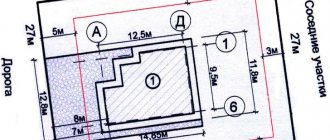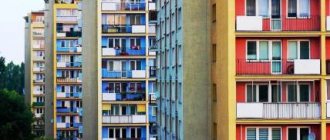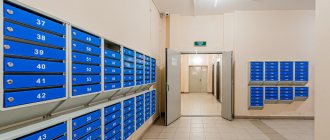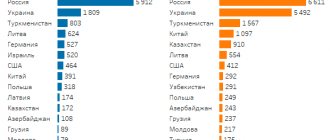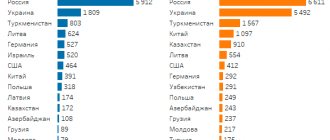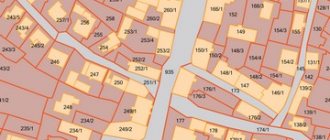The adjacent territory of an apartment building is a plot of land adjacent to the house and used by residents at their own discretion. If the site is not privatized, apartment owners can register ownership of it. But as a result, they have not only broad rights, but also responsibilities for the maintenance of common property.
All multi-storey residential buildings are built on a plot of land, which forms a small local area. Ownership of it is registered with Rosreestr in the usual manner.
What it is?
The local area is the space that belongs to a particular house. Its boundaries are fixed at the stage of construction of a residential property.
You can find out exactly how many meters are included in the local area of a house at a specific address from the cadastral documentation. Another option is to submit a request to the State Register.
The local area includes such objects as:
flower beds, shrubs and other landscaping elements;- benches and gazebos;
- sport complexes;
- parking spaces for vehicles;
- alleys and sidewalks;
- pedestrian paths;
- lanterns and other lighting elements;
- areas where waste bins are located.
In some local areas there is a complete list of objects, while in others there are only a few of the most significant elements.
Cleaning the local area of an apartment building in 2020
Not a single person doubts the need to clean the area adjacent to a residential apartment building. However, controversial situations often arise over who exactly is obliged to do this.
It is also important to know how often the territory is cleaned, by whose forces it is controlled, and whether the legislation establishes standards related to this process.
What is considered a local area?
Each residential building has an adjacent plot of land nearby. It is considered inalienable and is not considered in a legal sense as a separable entity. The name of this site is the adjacent territory of an apartment building. Let's list what it includes:
- the land on which the residential building is located;
- children's and sports ground;
- parking lot;
- fire passage;
- green spaces;
- other infrastructure and development elements.
Thus, on this site there are various facilities that residents can equally use. The area of the territory, its boundaries and other parameters are determined by the cadastral passport. Based on this data, the cost of cleaning the site is calculated.
Who should clean up?
Responsibilities for cleaning the local area are assigned to the following responsible organizations:
- The management company with which the residents entered into an agreement.
- Third-party companies that have entered into a contract with the owners of a residential property or with the HOA.
- Developer (in new houses, until the territory is privatized).
The residents decide which company will be responsible for maintaining the residential building and its surrounding areas during a general building meeting.
If it was decided to refuse the services of the HOA, then all responsibilities are transferred to the owners of the property. In other cases, the hired company bears obligations not only for the frequency, but also for the quality of cleaning.
If the local area is not a shared property, then the municipality is responsible for cleaning it.
Legal norms
Legislation to regulate the work of janitors has developed and approved time standards for performing each type of work.
Basically, when preparing the scope of job responsibilities of a janitor in 2021, they continue to rely on:
- Order of the State Construction Committee of the Russian Federation dated December 9, 1999 No. 139 “On approval of Recommendations for standardizing the labor of workers involved in the maintenance and repair of housing stock”
- Resolution of the Ministry of Labor of the Russian Federation dated June 24, 1996 N 38 “On approval of service standards for workers engaged in sanitary maintenance of households”
- Resolution of the State Construction Committee of the Russian Federation No. 170 dated September 27, 2003 “On approval of the Rules and Standards for the technical operation of the housing stock”
The regulations of local self-government regulate not only the general procedure for the maintenance and improvement of the territory of the municipality, but also who should clean the area near a store or catering establishment if they are located in a residential building, whose functions include keeping intra-block passages clean.
Read also: Structure of local governments.
What is included in the list of works to restore order?
The management company does not have the right to perform cleaning at its own discretion. There are specific norms and rules in this regard, prescribed at the legislative level.
The main list of works that must be implemented:
maintaining the cleanliness of sidewalks, roads, lawns, pedestrian areas;- removal of snow from the local area;
- maintaining the cleanliness and functionality of all elements installed in the local area;
- ensuring access to hatches, engineering units, water supply points - the presence of debris on them or their icing is unacceptable;
- caring for green spaces and keeping them clean;
- daily cleaning of bins with their scheduled disinfection;
- Maintaining cleanliness of waste collection areas.
If necessary, HOAs must use specialized equipment.
Frequency
The frequency of cleaning the surrounding area is regulated and agreed upon with the management bodies of the company or homeowners. In addition, the role of control bodies can be played by the municipality or, for example, Rospotrebnadzor. This is necessary when homeowners are dissatisfied with the quality of care for areas and objects. If the rules regulated by legislation and cleaning standards are not followed, an inspection by higher authorities is required.
Features for spring, summer, autumn and winter periods
List of works carried out in the summer:
- Sweeping the area: paths, sidewalks, etc. If the air temperature exceeds 30 degrees, watering of asphalt areas is carried out. This is done daily.
- Garbage collection.
- Watering and trimming green areas. This includes not only lawns, but also shrubs and trees. These procedures are carried out at least once every 2-3 days. The exact time depends on the air temperature and climatic conditions.
- Whitewashing and painting elements (borders, trees, benches, swings, etc.)
- Emptying trash bins and sweeping areas.
In winter, cleaning has the following features:
the territory is cleared of snow daily; if necessary, special equipment must be used;- places where there are plantings are loosened;
- pedestrian paths and sidewalks are sprinkled with sand and salt;
- icicles are knocked off roofs, sewer hatches must be cleared of ice;
- bins are emptied and cleaned regularly;
- Garbage is removed from children's and playgrounds.
If there is heavy snowfall outside, snow removal is carried out 2 times a day.
Features of treating the local area in autumn:
- Collecting rain and melt water to the wastewater system.
- Cleaning drains and gutters from falling leaves and debris.
- Cleaning the area from dirt and falling leaves, preparing for the winter.
Sweeping and washing of sidewalks should be carried out in the morning or late in the evening. This is done so as not to disturb residents.
Sanitation and garbage collection
In order to ensure the necessary sanitary conditions in the area located around the apartment building, management companies/homeowners' associations must:
- install durable waste bins with a capacity of at least 100 liters, which must be painted with a permanent dye, on separate asphalt/concrete areas;
- fence off areas around garbage disposals;
- provide illumination of this area;
- carry out daily collection of garbage/waste from all garbage containers;
- provide conditions for the access/turning of special equipment (garbage collection vehicles).
What to do if they don't clean it up?
If the local area is not cleaned, or the work is performed poorly, residents must file a complaint with the management company . To begin with, an oral complaint from the owners of a residential property is sufficient. It can be handed over by the chairman or a senior person in the house.
If the management company does not respond to comments, the claim is made in writing. Moreover, the manager is required to fill out an application for her admission.
Based on the complaint, the organizers of the HOA assemble a commission, which evaluates the quality of cleaning of the local area. The identified deficiencies must be eliminated as soon as possible.
Sometimes it happens that the management organization does not want to meet the residents halfway and fulfill their legal demands. In this case, the owners must contact the Housing Inspectorate , the local administration, the Prosecutor's Office, or even the court. The regulatory authorities will conduct their own inspection, based on the results of which a decision will be made.
If the HOA does not fulfill its obligations, then the owners have the right to terminate the previously drawn up agreement and choose a new management company. You should also submit an application for recalculation and refund of funds spent on unprovided services.
Monitoring the fulfillment of contract terms
Monitoring and control over the provision of services and their quality is the responsibility of:
- owners of premises in an apartment building;
- regional Rospotrebnadzor;
- local government bodies.
If residents have identified a violation of the terms of the concluded agreement, they can file a joint or individual complaint with the administration of the city or other locality. The verification must be completed within five working days.
Cost of services
The cost of cleaning a local area depends on a number of factors, including:
Regional affiliation. In each subject of the Russian Federation, an average price is unofficially established, which is the guideline for all companies and individuals.- Season. Cleaning costs less in summer than in winter.
- Scope of upcoming work. The larger it is, the more expensive the services of specialists will cost.
- Time and effort spent on cleaning. Naturally, removing snow 0.5 m thick is much more difficult than sweeping a footpath.
- Service level. Large companies employ trained people, they have technological equipment that allows them to carry out cleaning in the shortest possible time and with the highest quality.
- Current promotions and discounts. They can be offered by serious organizations.
Estimated cost depending on the time of year: in winter - from 15 rubles per sq. m. m., in summer - from 12 rubles per sq. m.
At whose expense is it carried out?
Cleaning of the local area is paid for by residents . Owners pay fees for house maintenance and repairs at a set rate. This amount includes the cost of cleaning the adjacent areas.
The calculation of the final cost for each tenant depends on the area of the apartment that he owns. HOAs are required to provide receipts indicating the tariff and the monthly amount due.
The cost of services is approved at the meeting . If necessary, the tariff can be reduced or increased. However, the HOA does not have the right to change the cost of services unilaterally.
Everything you need to know about cleaning the area can be found in this section.
Pay level
Employers set wages or payment for janitor services for the scope of work established by the contract and performance of official duties in accordance with standards independently to the best of their financial capabilities.
But it should not be less than the established minimum level if the daily cleaning rate requires a full working day.
The salary of a janitor depends primarily on the region of Russia in which he works, as well as the area and location of the territory being cleaned. This must be taken into account, as the difference can be noticeable.
The average salary of a janitor in the Russian Federation is 15,878 rubles per month, including small settlements. If we measure this value by the capitals of the constituent entities, its approximate size will be equal to 18,678 rubles per month. In the North, wages are predominantly higher, while in the South of Russia this figure is lower than the average. The East has similar indicators to the North (pay is 20% higher on average). In Central Russia the situation is also good and the salary there is above average.

